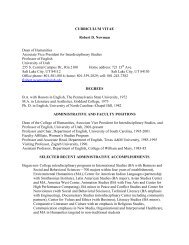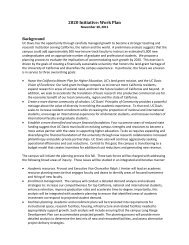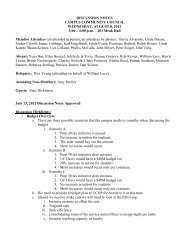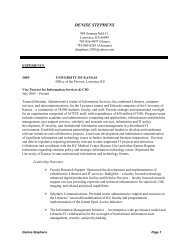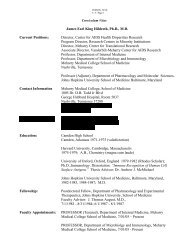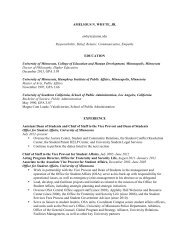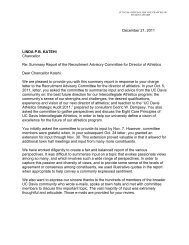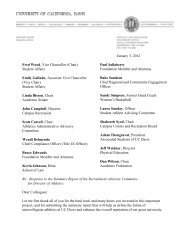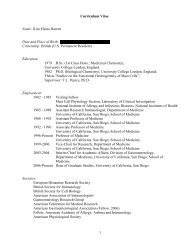Strengths, weaknesses, opportunities and threats (SWOT ... - UC Davis
Strengths, weaknesses, opportunities and threats (SWOT ... - UC Davis
Strengths, weaknesses, opportunities and threats (SWOT ... - UC Davis
- No tags were found...
Create successful ePaper yourself
Turn your PDF publications into a flip-book with our unique Google optimized e-Paper software.
<strong>UC</strong> <strong>Davis</strong> <strong>UC</strong> <strong>Davis</strong> Athletics<br />
2011 <strong>UC</strong> <strong>Davis</strong> Strategic Athletics Athletics Audit<br />
Strategic Audit 2011<br />
<strong>Strengths</strong>, Weaknesses<br />
Opportunities, & Threats<br />
collegiate athletics<br />
C A S A<br />
strategy advising
<strong>UC</strong> <strong>Davis</strong> Strategic Audit<br />
<strong>Strengths</strong>, Weaknesses, Opportunities, Threats<br />
Current Context of Aggie Athletics<br />
The eight core principles identified by the university in order to guide the process<br />
of moving from NCAA Division II to Division I were:<br />
1. <strong>UC</strong> <strong>Davis</strong> must offer a program that does not compromise the University’s<br />
focus on the academic integrity of student–athletes<br />
2. Admissions <strong>and</strong> graduation st<strong>and</strong>ards must in no way be specially altered or<br />
amended for student-athletes<br />
3. There can be no “tiering” among <strong>UC</strong> <strong>Davis</strong> sports with some sports <strong>and</strong><br />
their athletes receiving a better st<strong>and</strong>ard of treatment than others<br />
4. <strong>UC</strong> <strong>Davis</strong> cannot retreat from its Title IX progress but must continue to<br />
exp<strong>and</strong> its efforts <strong>and</strong> compliance<br />
5. <strong>UC</strong> <strong>Davis</strong> cannot reduce its broad-based program but rather must seek to<br />
add sports<br />
6. The athletics program cannot depend for its financial survival on its record<br />
of wins <strong>and</strong> losses<br />
7. Permanent core funding must come from students <strong>and</strong> the institution<br />
rather than from a dependency on external resources<br />
8. The athletics department at <strong>UC</strong> <strong>Davis</strong> must maintain a formal connection to<br />
the mission of the University , including preserving the teacher/coach role<br />
Many <strong>UC</strong>D administrators, faculty, coaches, alumni <strong>and</strong> staff that were<br />
interviewed referred to these principles <strong>and</strong> described them as representing the<br />
“The <strong>Davis</strong> Way” of athletics. Although worthy principles for NCAA Division III<br />
programs, principles 3, 5, 6, <strong>and</strong> 7 contradict the philosophy of NCAA Division I<br />
institutions. Principle 8 is also a principle seldom seen at Division I institutions. In<br />
the late 1970’s, NCAA Division I institutions established a principle of selfsufficiency<br />
for its intercollegiate athletics programs. As a result, Division I moved<br />
farther away from the “educational model” of athletics <strong>and</strong> more toward the<br />
SW 1
“business model”. At many institutions, especially those at the highest Division I<br />
level, athletics programs are treated as auxiliary enterprises within the university.<br />
This model has caused programs to place an emphasis upon potential revenue<br />
generating sports by reinvesting their resources to insure those sports that have<br />
the potential to generate income receive competitive funding to be successful.<br />
Men’s basketball <strong>and</strong> football have historically received greater resources in an<br />
effort for these sports to be self-sufficient <strong>and</strong>, hopefully, provide revenues for<br />
the entire department. Often for Title IX purposes a selected number of women’s<br />
sports have received comparable budgets. This practice has led to a tiering of<br />
sports. Many institutions have had to reduce the number of sport offerings <strong>and</strong><br />
reinvest in those sports which the conference emphasizes in order to be<br />
competitive. Without being competitive it is difficult for programs to generate<br />
revenue to become as self-sufficient as possible. This need contradicts principles<br />
3, 5, 6, <strong>and</strong> 7 in the core principles. Because of the need to be competitive,<br />
coaches have broadened their duties to include increased emphasis on recruiting<br />
<strong>and</strong> fundraising. The time commitments for these affect the teacher/coach<br />
model suggested in the core principles.<br />
A critical component of the transition from Division II to Division I was developing<br />
creative solutions to close the funding gap between the NCAA Division II past <strong>and</strong><br />
the NCAA Division I future of the Aggies. Athletics is a part of <strong>UC</strong> <strong>Davis</strong>’ $1 billion<br />
campaign goal. A $16 million goal is established to be reached by 2014 with an<br />
ultimate goal of $30 million for a permanent endowment fund for intercollegiate<br />
athletics. The drive targets investment in four key building blocks for success:<br />
facilities, grants-in –aid, endowments <strong>and</strong> student support services. The existing<br />
<strong>Davis</strong> level of support for each of these areas has historically been behind<br />
competitive Division I st<strong>and</strong>ards.<br />
The grants-in-aid, endowment, <strong>and</strong> student support deficiencies all continue to be<br />
priorities, but the greatest funding challenges for developing a strong competitive<br />
program is upgrading its athletic facilities. The next phases of the Aggie Stadium<br />
expansion project are intended to address the strength <strong>and</strong> conditioning, athletic<br />
medicine, administrative, coaching <strong>and</strong> academic support office spaces.<br />
Additionally, exp<strong>and</strong>ing seating in the football stadium will be required in an<br />
effort to increase revenue for the program.<br />
SW 2
Recommendations related to Current Context of Aggie Athletics<br />
1. Evaluate <strong>and</strong> adjust the University’s Core Principles to more closely<br />
coincide with NCAA Division I, Big West <strong>and</strong> Big Sky philosophies <strong>and</strong><br />
practices.<br />
2. Develop facility priorities that will attract outst<strong>and</strong>ing student athletes by<br />
providing excellent training, tutoring, medical <strong>and</strong> fitness facilities.<br />
Secondly, provide spectator facility enhancements that will provide<br />
opportunity to significantly increase revenue. Obviously, the football<br />
seating <strong>and</strong> fan services should receive a high priority.<br />
3. With increased expectations on coaching staffs, the teacher/coach role<br />
needs to be reviewed to determine whether another model might better<br />
serve students desiring to develop athletic skills <strong>and</strong> increase their fitness<br />
levels.<br />
<strong>SWOT</strong> Analysis<br />
Campus interviews <strong>and</strong> ongoing research have revealed a number of areas of<br />
strength as well as weakness that <strong>UC</strong> <strong>Davis</strong> faces as the school confronts the<br />
challenge of competing successfully at the Division I level <strong>and</strong> finding successful<br />
balance in competitive, academic <strong>and</strong> financial terms.<br />
<strong>Strengths</strong><br />
High level academics: <strong>UC</strong> <strong>Davis</strong> is currently a top ten public research I<br />
institution <strong>and</strong> is in the internationally acclaimed crown of higher education that<br />
is the University of California system. It is in the “most selective” category of<br />
universities according to US News <strong>and</strong> World Report. <strong>UC</strong> <strong>Davis</strong> has a number of<br />
nationally-ranked academic departments <strong>and</strong> programs.<br />
Student-athlete development: With the transition to Division I athletics<br />
being a fairly recent change (officially marked by the 2004-2005 competitive<br />
season), the culture of athletics at <strong>UC</strong> <strong>Davis</strong> still retains a commendable sense of<br />
athletics participation being a co-curricular part of the undergraduate experience.<br />
Student-athletes continue to perform at a high level in the classroom even as the<br />
level of athletics has risen. Increases in resources have allowed some teams to<br />
SW 3
ecruit athletes with considerable academic <strong>and</strong> athletic ability, raising the bar for<br />
performance in both areas. The bike-friendly setting, relative proximity to<br />
Sacramento <strong>and</strong> San Francisco <strong>and</strong> charming college town atmosphere give<br />
coaches powerful recruiting tools to use when appropriately leveraged. The<br />
opportunity to convince prospects as to the nature of the student-athlete<br />
experience at <strong>UC</strong> <strong>Davis</strong> as a holistic, balanced, <strong>and</strong> integrated chapter in their lives<br />
is a clear recruiting advantage.<br />
Effective <strong>and</strong> adaptable coaches: There are some very talented <strong>and</strong><br />
motivated coaches within the department who have the potential to coach <strong>and</strong><br />
lead teams to a higher competitive level. Their ability to gain relative success<br />
during the transition from Division II is a testament to the creative use of<br />
resources <strong>and</strong> adaptability to a changing <strong>and</strong> increasingly complex environment.<br />
The 2004-2005 season, the first season in which all <strong>UC</strong> <strong>Davis</strong> sports teams<br />
competed with Division I schedules, was evidence that <strong>UC</strong> <strong>Davis</strong> responded well<br />
to Division I competition. Football finished the year 6-4, men’s basketball 11-17,<br />
women’s basketball 9-18 <strong>and</strong> women’s soccer 8-9-1. Given the logistics <strong>and</strong><br />
timing of recruiting, it is expected that the Aggies will improve quickly with the<br />
recruitment of Division I caliber scholarship student-athletes as more full<br />
scholarships come online.<br />
Student body support: A key strength of the university is clearly the support<br />
of the undergraduate student body <strong>and</strong> their enthusiasm for quality competitive<br />
athletics. The transition to Division I was made possible by the Facilities <strong>and</strong><br />
Campus Enhancement (FACE) initiative which levied a significant increase in<br />
student fees in order to largely fund campus upgrades that would improve<br />
athletic facilities. New projects include the Schaal Aquatics Center <strong>and</strong> the Multi<br />
Use Stadium, both of which are significant improvements of antiquated<br />
intercollegiate athletics <strong>and</strong> recreationally oriented facilities. Of the $22,542,7 83<br />
million projected sources of funds for the 2010-2011 season, $18.7 million<br />
(76.3%) comes from the FACE ($2,975,507 million), the Student Activities <strong>and</strong><br />
Services Initiative (SASI, $7,385,184 million) the Campus Expansion Initiative (CEI,<br />
$5.0 million) <strong>and</strong> the Student Services fee ($3,169,279 million). Students on<br />
campus are generally passionate about Aggie athletics <strong>and</strong> feel connected as a<br />
result of broad participation <strong>and</strong> the integration of intercollegiate athletics<br />
coaches into physical education activity programs.<br />
SW 4
Weaknesses<br />
Culture: The prevailing culture of the athletics program at <strong>UC</strong> <strong>Davis</strong> explains<br />
many of the challenges that the school faces in order to compete successfully at a<br />
higher level within Division I. What was a commendable <strong>and</strong> noteworthy example<br />
of competitive <strong>and</strong> participatory athletics program, integrated within an<br />
environment that truly emphasized participation as a developmental component<br />
of the undergraduate experience, leaves significant gaps when measured against<br />
the current world of Division I intercollegiate athletics. There are examples of<br />
schools that maintain high academic st<strong>and</strong>ards, support a large number of teams,<br />
<strong>and</strong> compete at the highest level in Division I. Stanford University <strong>and</strong> the<br />
University of Michigan are examples of institutions with high academic st<strong>and</strong>ards,<br />
outst<strong>and</strong>ing facilities <strong>and</strong> huge operating budgets. They have only been able to do<br />
so as a result of a combination of fund raising <strong>and</strong> development, ticket sales<br />
particularly from football <strong>and</strong> basketball, television rights income, sponsorships<br />
<strong>and</strong> endowment funds. Their budgets are four to five times the current level at <strong>UC</strong><br />
<strong>Davis</strong>. Much of the resistance from faculty <strong>and</strong> students to these types of<br />
initiatives comes from concerns that the Division I athletic culture would change<br />
<strong>UC</strong> <strong>Davis</strong>’ identity. However, without a cultural reorientation towards a model<br />
that is consistent with Division I, it will be difficult to elevate the Aggies’s level of<br />
competitive success. The eight core principles that define the current culture are<br />
completely consistent with <strong>UC</strong> <strong>Davis</strong>’ history of athletics but at least five of the<br />
principles represent an impediment to increased competitiveness in Division I.<br />
There is a portion of the coaching, professional staff <strong>and</strong> alumni that adhere to<br />
these principles <strong>and</strong> will likely resist any cultural shift.<br />
Facilities: In spite of the upgrades that the 1999 FACE initiative made possible,<br />
many facilities are sub-st<strong>and</strong>ard when compared to institutions within even the<br />
lowest tier of Division I athletics. In many sports, <strong>UC</strong> <strong>Davis</strong> athletics facilities are<br />
also used by the Departments of Physical Education, Recreation <strong>and</strong> Intramurals.<br />
Competitive <strong>and</strong> practice facilities, academic support facilities, medical facilities,<br />
training facilities, <strong>and</strong> administrative <strong>and</strong> coaches offices are old <strong>and</strong> outdated.<br />
Furthermore, in spite of the improvements in the Multi Use Stadium, expansion<br />
will have to go beyond the planned 30,000 seat cap in order to create the scale of<br />
program that has the potential to generate revenues to support all programs<br />
through ticket sales <strong>and</strong> advertising. Currently, there is not a definitive date for<br />
the additional 20,000 seats that would get the stadium to that cap level.<br />
SW 5
Facility improvements have functional implications. They enhance the ability of<br />
teams to train <strong>and</strong> compete at the highest possible level; however, the most<br />
important impact is on recruiting. The condition of the current facilities creates a<br />
recruiting disadvantage with relevant <strong>and</strong> potential competitors. In addition, it<br />
will be very difficult, if not impossible, to generate additional revenues <strong>and</strong><br />
improve attendance without major renovations or new facility projects. The<br />
basketball facility is adequate by Big West conference st<strong>and</strong>ards, but significant<br />
expansion would be needed to meet Mountain West st<strong>and</strong>ards let alone the PAC<br />
12 benchmark. Attracting, retaining, <strong>and</strong> maintaining quality staff <strong>and</strong> student<br />
athletes will require considerable improvements in office spaces, athletic training<br />
<strong>and</strong> strength conditioning facilities <strong>and</strong> academic support operations.<br />
Operations: Key operational shortcomings that have been noted focus on<br />
business operations (accounting), development, game day operations <strong>and</strong><br />
academic support. There are some coaches, staff <strong>and</strong> campus members who<br />
think that, particularly, the development staff is already too large. However,<br />
during the transition from Division II there has been only a moderate investment<br />
in scaling up administrative <strong>and</strong> operational staff, not simply in terms of abilities<br />
<strong>and</strong> skills but also in absolute numbers <strong>and</strong> processes. What was adequate for a<br />
Division II education based model does not meet the st<strong>and</strong>ard for athletic<br />
operations that are required to train <strong>and</strong> compete at a higher level, generate<br />
significant revenue from game day operations <strong>and</strong> develop fundraising streams.<br />
With an increase in expectations of competitive performances comes a<br />
substantial increase in administrative support requirements for coaches, in terms<br />
of compliance paperwork, promotions, recruiting correspondence, travel, etc.<br />
There will also be an inevitable need for greater levels of direct academic support<br />
for student athletes. Coaches currently multi-task <strong>and</strong> perform more<br />
administrative functions <strong>and</strong> teaching requirements than their counterparts at<br />
other institutions are required to do. This reduces coaching time that could be<br />
spent improving team performance.<br />
Division I Model: The key to being able to compete at the Division I level is<br />
finding creative ways to generate enough revenue from multiple sources in order<br />
to cross-subsidize the various intercollegiate athletics operations that are strictly<br />
cost centers. All of these <strong>opportunities</strong> require an investment in human resources<br />
<strong>and</strong> facilities that <strong>UC</strong> <strong>Davis</strong> has not made at this point. There is concern from<br />
different quarters of the campus about moving to a Division I athletic model.<br />
SW 6
There are aspects of the Division I model that are indispensable to an institution<br />
that hopes to compete on a level playing field with other universities that fully<br />
embrace the Division I philosophy. One important consideration is the scope of<br />
the athletic program. <strong>UC</strong> <strong>Davis</strong> has a broader program than most universities in<br />
the Big Sky, Big West, Mountain West <strong>and</strong> PAC-12 conferences. Only Stanford<br />
University <strong>and</strong> the University of California Berkeley have a more extensive<br />
program than <strong>UC</strong> <strong>Davis</strong>. <strong>UC</strong> Berkeley has struggled trying to maintain a broad<br />
based program <strong>and</strong> is faced with a huge annual financial deficit. Without a<br />
significant increase in revenues, <strong>UC</strong> <strong>Davis</strong> will need to consider reinvesting its<br />
resources in order to be competitive in even its current conference alignments.<br />
Opportunities<br />
Innovation in Division I model: There is an opportunity for <strong>UC</strong> <strong>Davis</strong> to<br />
pursue a new model that can leverage its existing strengths <strong>and</strong> address some of<br />
the key challenges facing the department. There is a dem<strong>and</strong> for universities that<br />
can provide excellence in both academics <strong>and</strong> athletics, <strong>and</strong> yet provide an<br />
environment that preserves the notion of student-athlete development as a<br />
priority. An analysis of Stanford University’s intercollegiate program to determine<br />
the possibility of <strong>UC</strong> <strong>Davis</strong> developing a version of its operation that preserves<br />
high levels of academic integrity but provides adequate resources for conference<br />
success in the Big West <strong>and</strong> Big Sky Conferences may be useful.<br />
ICA/PE/Recreation: Broad-based participation in recreation, intramurals,<br />
physical education <strong>and</strong> intercollegiate athletics is a critical part of <strong>UC</strong> <strong>Davis</strong> culture<br />
<strong>and</strong> should be retained, but as previously noted, a structural evaluation of the<br />
relationship may be beneficial for each unit. Sharing of facilities should be<br />
possible, but a fully allocated cost model should be created to better underst<strong>and</strong><br />
operating <strong>and</strong> replacement costs between the different units. A consistent<br />
concern expressed during interviews with current coaches indicates a weakness in<br />
communication among staffs in the separate areas. In athletics staff interviews<br />
many felt that intercollegiate athletics should be given greater flexibility <strong>and</strong><br />
priority in scheduling use <strong>and</strong> access to various facilities.<br />
SW 7
Business Operation: <strong>UC</strong> <strong>Davis</strong> has an excellent record of fiscal responsibility.<br />
According to the EADA dataset included in the report, the department<br />
consistently operates within tight budget constraints. As the level of athletic<br />
performance improves the university must assert sound financial operation as<br />
part of a new model of sound athletic management which includes greater<br />
transparency.<br />
Added revenue: Opportunities for revenue come from high profile sports<br />
that attract fans <strong>and</strong> their disposable income for on-campus contests. Athletics<br />
must have administrative <strong>and</strong> operational responsibility for athletics support<br />
groups, event parking <strong>and</strong> concessions. In addition, ICA should have increased<br />
percentages of revenues from these areas as well as from online athletics apparel<br />
<strong>and</strong> licensing rights. The latter should be promoted by ICA in its publications <strong>and</strong><br />
other marketing programs. Consideration should be given to revenues from<br />
major <strong>and</strong> gift campaigns to ICA. The athletics ticket office should be under the<br />
control of the Department of ICA. Not all of these areas can be improved<br />
concurrently, but the new department leadership should model the potential that<br />
each area has <strong>and</strong> engage the business office in creative solutions to increased<br />
profitability.<br />
Technology applications: In the face of limited resources, every effort<br />
should be made to leverage low-cost/no-cost <strong>opportunities</strong> for staff functions like<br />
marketing <strong>and</strong> promotions, broadcasting games <strong>and</strong> results, connecting with<br />
alumni <strong>and</strong> donors, etc. There are a wide variety of applications of social <strong>and</strong><br />
digital media that are not currently being utilized but are critical to current<br />
fundraising/friendraising <strong>and</strong> public relations efforts. Several coaches discussed<br />
the relative invisibility of <strong>UC</strong> <strong>Davis</strong> athletics <strong>and</strong> that problem could be solved with<br />
minimal investment through the application of technology. The current<br />
administrative <strong>and</strong> coaching staffs may require training on various platforms;<br />
therefore, some thought should be given to the creation of a media lab facility<br />
where staff can obtain tutorials on the use of platforms such as Face book <strong>and</strong><br />
Twitter. There may be <strong>opportunities</strong> to employ undergraduate interns to staff a<br />
lab <strong>and</strong> possibly provide regular support for teams <strong>and</strong> department activities.<br />
Travel management: Travel is reportedly inefficient in terms of<br />
organization <strong>and</strong> the ability to manage costs. Significant savings in cost <strong>and</strong> time<br />
management can be realized by either using a central travel agency or by training<br />
those who travel. Assistant coaches, secretaries, <strong>and</strong> other staff with minimal<br />
SW 8
training can benefit by learning to use internet sites. The possibility of value<br />
managed relationships with local providers (e.g. bus companies <strong>and</strong> hotels)<br />
should also be evaluated by the business office staff.<br />
Outsourcing: The business office should evaluate the possibility of an<br />
outsourcing contract with vendors to automate some of the bureaucratic<br />
requirements <strong>and</strong> manage administrative <strong>and</strong> oversight costs. It is possible to<br />
bridge the gap between current levels of administration <strong>and</strong> the need at the next<br />
level through the use of web-based data management tools to facilitate<br />
compliance audits <strong>and</strong> tracking of recruiting activities.<br />
Promotions <strong>and</strong> Marketing: Almost every coach expressed enthusiasm <strong>and</strong><br />
passion for the br<strong>and</strong> that <strong>UC</strong> <strong>Davis</strong> could potentially have, but almost all believe<br />
that the br<strong>and</strong> is not currently being adequately promoted. Even within the local<br />
Sacramento media market, there is not sufficient awareness of Aggie events or<br />
results. This is another challenge that can be addressed through the application<br />
of digital media. For example, every sport should have sideline “reporters” who<br />
tweet results at a play-by-play level <strong>and</strong> the availability of each sport’s Twitter<br />
feed should be well-publicized to current students, alumni, parents, fans <strong>and</strong><br />
media. Professional sports are beginning to use this channel with great effect.<br />
The same technology conclusion is true for improvement in development/donor<br />
operations through use of digital media <strong>and</strong> web-based technologies for<br />
communication <strong>and</strong> friendraising.<br />
Game day experience: Another consistent theme is the difficulty of<br />
creating game day experiences that attract <strong>and</strong> retain fan interest. The<br />
relationship between Campus Recreation <strong>and</strong> Intercollegiate Athletics apparently<br />
creates logistical complication <strong>and</strong> customer service issues that mitigate against<br />
increasing attendance. ICA control of the game day fan experience would open<br />
up <strong>opportunities</strong> for increased ticket sales <strong>and</strong> a deeper level of community<br />
connection as well as reduced game day stress for coaching staffs.<br />
Culture: There is an opportunity for the new leadership to dramatically improve<br />
department morale through the development of unifying departmental themes<br />
<strong>and</strong> approaches to training, competition, <strong>and</strong> team building. Many of the coaches<br />
do not have a sense of where the department is going as a whole, have little or no<br />
contact with their colleagues, <strong>and</strong> do not feel as if they have a clearly defined role<br />
in a larger enterprise. Though the athletic department offices are not yet<br />
centrally aggregated, an intentional effort by the new athletic director to regularly<br />
SW 9
meet with all head coaches will greatly aid in communication <strong>and</strong> unity. In<br />
addition, some consideration should be given to developing a best practice<br />
database for recruiting, marketing <strong>and</strong> development work in order to enable<br />
sharing <strong>and</strong> collaboration across the department. Resource limitations mean that<br />
coaches will have to follow an entrepreneurial model of management, but they<br />
should be able to access the significant expertise that already exists in the<br />
department among their colleagues. Other possible steps include regularly<br />
scheduled coaches’ roundtables, creation of a formal coaches’ leadership<br />
structure to increase their sense of empowerment <strong>and</strong> unity, <strong>and</strong> regular<br />
communication of policy changes <strong>and</strong> decisions by the athletic director. Not<br />
every decision must be explained or approved by the coaches, but there is a clear<br />
sense of disconnect that increases the sense of isolation by coaches from<br />
administrative functions.<br />
Service attitude: A frequent complaint from coaches across NCAA<br />
institutions is the attitude of service in administrative offices. <strong>UC</strong> <strong>Davis</strong> is no<br />
exception. The coaches perceive that the Athletics Department lacks a culture of<br />
customer service. Rather, the coaches often experience a sense of being “policed”<br />
by administrators <strong>and</strong> put into a mode of serving administrators, rather than<br />
being supported as the most direct influencers in the lives of student-athletes. In<br />
the interview process with coaches there was a number of comments regarding<br />
“demotivating” styles of leadership, management, <strong>and</strong> communications from<br />
administrative <strong>and</strong> support staff.<br />
Student pride: A relatively simple opportunity for cultural change would be<br />
to enhance <strong>and</strong> develop a culture of pride among student-athletes. Some student<br />
athletes expressed disappointment that is no annual recognition program for<br />
student-athletes in their sport. Recognition programs celebrate the achievements<br />
of student athletes <strong>and</strong> can help capture a sense of loyalty <strong>and</strong> institutional pride.<br />
Acculturating student-athletes to the idea of institutional support <strong>and</strong> annual<br />
giving is far easier before they are graduated than five years post-graduation.<br />
SW 10
Threats<br />
Haste: Appropriate <strong>and</strong> strategic pacing is rare in intercollegiate athletics when<br />
it comes to major departmental changes. No athletic department has successfully<br />
moved up through the hierarchy of Division levels <strong>and</strong> conferences without first<br />
achieving a leadership position in both athletic <strong>and</strong> financial performance at their<br />
current level. It is impossible to simply purchase a leap from one conference or<br />
Division to the next. Therefore, one of the greatest <strong>threats</strong> facing <strong>UC</strong> <strong>Davis</strong> is<br />
overreach, that is setting aspirations <strong>and</strong> goals for the athletic department that<br />
are not adequately matched by available resources. While it is possible to<br />
dramatically increase the amount of financial resources available for investment<br />
in facilities, operations, <strong>and</strong> coaching salaries, it will require judicious<br />
consideration of the order, scale, <strong>and</strong> timing of investments if the university is to<br />
avoid the overreach that characterizes the majority of programs that chase the<br />
elite success in intercollegiate athletics.<br />
Stagnation: Another threat is loss of momentum from the initial transition to<br />
Division I. Initially, there was considerable enthusiasm <strong>and</strong> excitement on campus<br />
<strong>and</strong> in the local community about the change. However, there appears to be a<br />
sense within the department that interest has lessened. No doubt the financial<br />
reductions across the campus as well as in athletics have affected that interest.<br />
There is currently a perception among the coaching staff that the department is<br />
not uniformly moving in the direction of being highly competitive in Division I.<br />
Leadership: The current culture seems to be fraught with a sense of futility,<br />
frustration, <strong>and</strong> concern for the lack of visible leadership. A number of coaches<br />
identified the absence of a clear <strong>and</strong> compelling vision for the department as one<br />
of the major stumbling blocks to progress. There are also coaches,<br />
administrators, <strong>and</strong> support staff who have lengthy tenures that have been<br />
unable to evolve their mindset regarding operations <strong>and</strong> expectations from the<br />
Division II past. The new athletic director will have to clearly delineate an<br />
elevated level of expectations in terms of performance <strong>and</strong> efficiency as he or she<br />
considers new <strong>and</strong> creative models that may require a re-organization in order to<br />
facilitate a more professionalized sport management approach.<br />
SW 11



